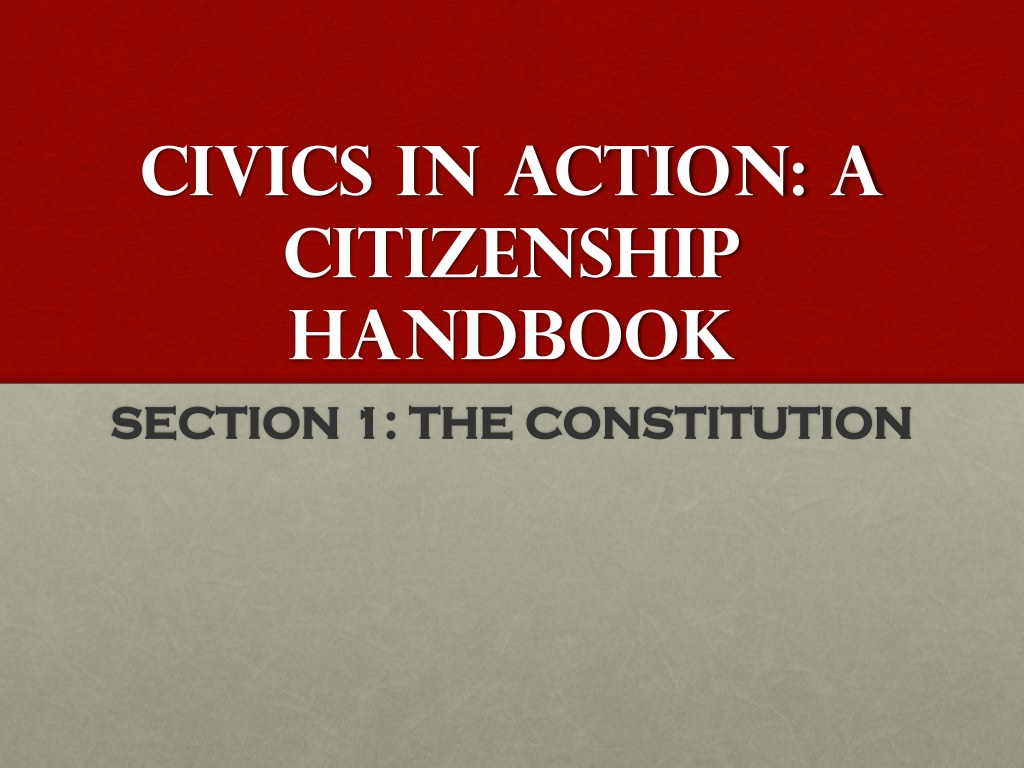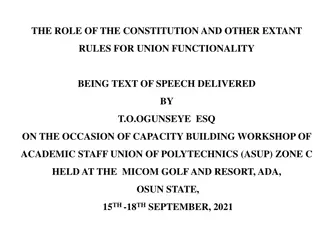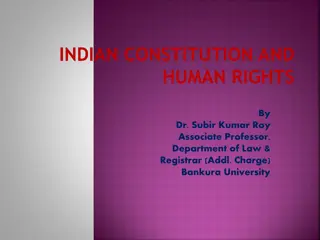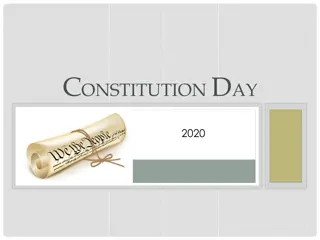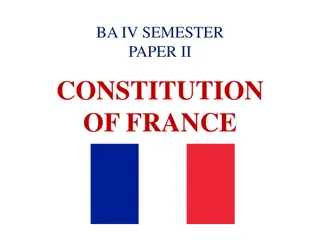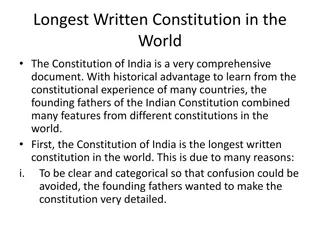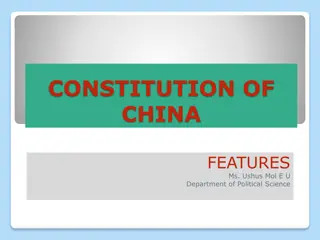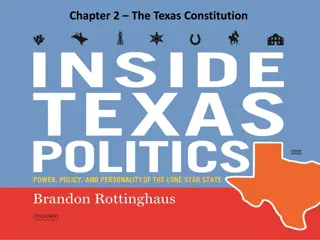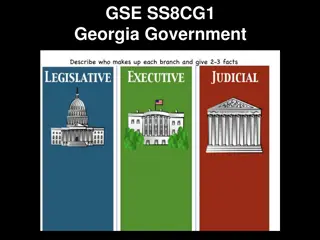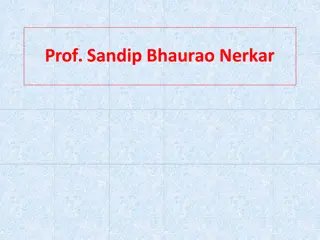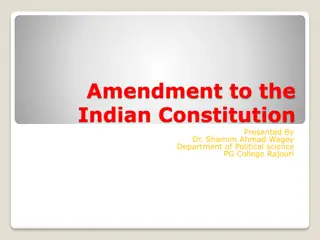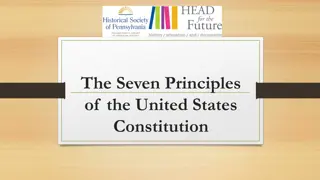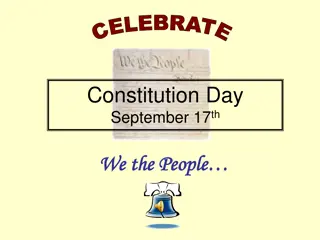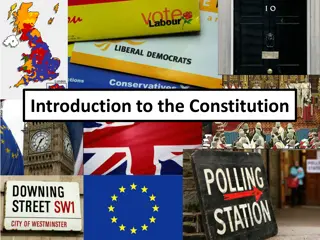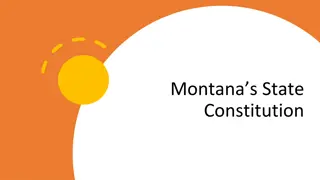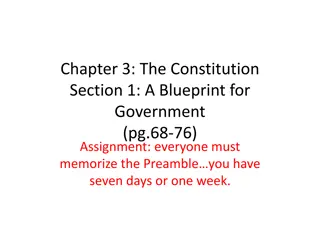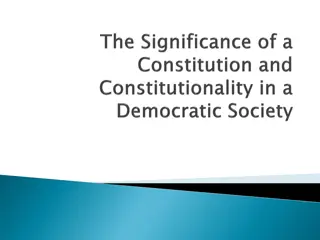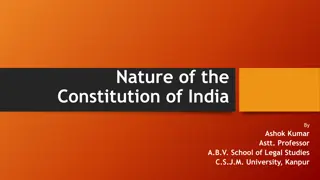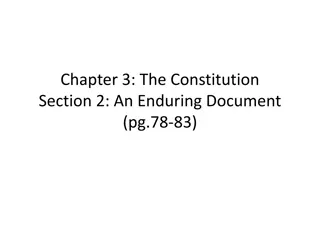Understanding the Foundation of US Government: The Constitution and its Principles
The Constitution of the United States outlines key principles governing the government, including popular sovereignty, republicanism, limited government, federalism, separation of powers, checks and balances, and individual rights. It establishes six goals for the US government and delineates the powers between the federal and state governments. The three branches of government - legislative, executive, and judicial - each serve distinct functions to maintain a system of checks and balances.
Download Presentation

Please find below an Image/Link to download the presentation.
The content on the website is provided AS IS for your information and personal use only. It may not be sold, licensed, or shared on other websites without obtaining consent from the author. Download presentation by click this link. If you encounter any issues during the download, it is possible that the publisher has removed the file from their server.
E N D
Presentation Transcript
Civics in Action: a Citizenship handbook SECTION 1: THE CONSTITUTION SECTION 1: THE CONSTITUTION
PREAMBLE/SIX GOALS The Preamble is the introduction to the U.S. Constitution; it states the goals of the U.S. government The six stated goals of the United States government are: 1) Form a more perfect union 2) Establish justice 3) Insure domestic tranquility 4) Provide for the common defense 5) Promote the general welfare 6) Secure the blessings of liberty, now/future generations
PRINCIPLES OF THE CONSTITUTION 1) Popular sovereignty- people are the source of the government s power 2) Republicanism- citizens elect representatives to serve them in government and lawmaking 3) Limited Government- government powers carefully controlled; specific powers explicitly stated 4) Federalism- government powers are divided between national and state/local governments 5) Separation of Powers- federal government divided into three branches; each has a particular job/function 6) Checks and Balances- each branch exerts control/has a check (and is checked) by the other two branches 7) Individual Rights- all citizens are afforded the basic liberties/rights promised to us in the Bill of Rights
POWERS OF THE U.S. GOVERNMENT ENUMERATED- powers granted only to the Federal government RESERVED- powers authorized only for the states to exercise/implement CONCURRENT- powers shared by both Federal and State governments
Three branches of government Legislative Branch: creates the nation s laws, manages federal spending/federal budget; often referred to as Congress; consists of the House of Representatives and the Senate Executive Branch: enforces the nation s laws, manages the day-to-day operations of government; is led by the President Judicial Branch: interprets the nation s laws, determines if laws and government actions are Constitutional; comprised of the Supreme Court and
Checks and Balances This unique feature of American government ensures a balance of power among the three branches of government; prevents one branch from excessive abuses of power
States and amendments * The states play a critical role in the creation of Constitutional amendments (formal changes to the Constitution). 1) States can request national conventions where amendments can be proposed 2) States may also ratify amendments and make them official The Framers intentionally made ratification of amendments more difficult than proposing them.
The Bill of Rights Passed in 1791, these are the first ten amendments to the Constitution. Specific LIST of basic rights/liberties promised to all Americans by the United States government.
Proposing/ratifying an amendment PROPOSING AN AMENDMENT: 1) 2/3 vote by BOTH the House and Senate OR 2) 2/3 of all states call conventions to discuss Method # 2 has never happened RATIFYING AN AMENDMENT: 1) 3/4 vote of approval by all state legislatures OR 2) 3/4 of all states approve in special conventions
Elastic Clause Congress has the authority to make all laws necessary and proper to carry out its duties Implied Powers Powers that Congress has that are not specifically stated in the Constitution
freedoms/liberties in the bill of rights 1. Freedom of speech, religion, assembly, press, petition 2. State militias; right to bear arms 3. No housing of troops in private residence 4. No unlawful searches, seizures of property 5. Cannot deprive a person of life, liberty, or property without due process of law 6. Right to a speedy and public trial 7. Right to a jury trial in cases involving common law 8. No excessive bail or cruel and unusual punishment 9. Rights are not limited to those listed in #1-8 10. Powers not given to the Federal government are reserved to the states and people
Judicial review A crucial level of authority given A crucial level of authority given to the Supreme Court: this court to the Supreme Court: this court may determine if a law is may determine if a law is unconstitutional. If so, the law unconstitutional. If so, the law must be changed, made void, or must be changed, made void, or an amendment must be added to an amendment must be added to the Constitution which the Constitution which allows it. allows it.
